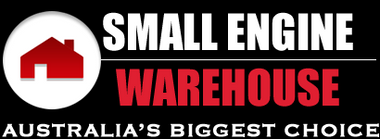Vertical shaft engines are found on lawnmowers, ride on mowers and zero turn mowers. Quality lawnmowers and ride on mowers will usually outlast the engine. So when considering replacing your engine, keep in mind that some engine manufacturers provide a much broader engine lineup than others. The broader the engine line, the more choices you have in terms of power, features and price levels. To be sure you find the combination of features and power that’s right for you, look for an engine model that matches these important factors outlined below.
Power
Engine power is the single biggest difference from one piece of equipment to the next. For instance, the more cutting power a lawnmower has the more easily it will maintain the speed of the blade and deliver a consistent, quality cut, even under tough conditions.
• Engine size
In combination with engine configuration, engine size is the most important factor in a lawnmower’s ability to handle tough, demanding jobs. The higher the torque or horsepower rating, the more power the machine has to get the job done. For walk-behind mowers, engine sizes typically range from 4.50 to 8.75 gross torque. For riding mowers the sizes typically range from 10.5 to 26.0 gross horsepower. In walk-behind mowers, more torque means a cleaner and more even cut, even in high, thick grass.
• Horsepower – is the rate of doing work over time. It is a more meaningful measure of power for riding lawnmower engines. That’s because power in ride engines is distributed to the transmission, wheels, hydraulics, and the cutting blades via various gear ratios. This makes horsepower a more meaningful measure of the ride engine’s ability to get the job done.
Engine configuration
Walk-behind lawnmowers are typically equipped with smaller side valve or Overhead Valve (OHV) engines.
• Side valve engines provide exceptional value and performance at a variety of power levels.
Light-duty engine sizes range from 4.50 to 5.50 ft-lbs of torque.
Mid- to heavy-duty engine sizes range from 6.25 to 6.75 ft-lbs of torque.
OHV engines offer significantly more power, r • un smoother and quieter, and are better for the environment since they burn fuel more efficiently. Direct Overhead Valve (DOV™) engine technology is also available. It has fewer moving parts, which further reduces engine size and vibration.
Heavy-duty engine sizes range from 7.00 to 8.75 ft-lbs of torque
Riding lawnmowers are typically equipped with larger single-cylinder or V-Twin (two cylinder) OHV engines.
• Large, single-cylinder engines cover a broad spectrum of power levels and range from being designed for value to being designed for premium performance and durability.
• V-Twin engines take performance to the next level. They provide greater horsepower and better balance that translates to lower vibration and greater comfort, and are quieter than single cylinder engines. And, they run cooler and burn cleaner.
Mower configuration
This is a matter of mower deck size, features and design. Mower configuration will determine the amount of engine power needed to get the job done easier and faster.
• Push and side discharge walk-behind mowers with smaller decks will require the least amount of power. Look for light-duty side valve engines in these cases.
• Rear bagger and self-propelled mowers, and mowers with larger cutting widths, will require more power. Look for larger OHV engines in these cases.
• Riding mowers with smaller decks and gear-driven transmissions typically require less power. Look for large single-cylinder engines in these cases.
• Riding mowers with larger decks and hydraulic drive trains demand more power. Look for larger V-twin, OHV engines in these cases, and when the mower will be used for towing other equipment.
Durability and Performance
It is important to select an engine manufacturer that has a long history of delivering durability and performance. One that offers an extensive lineup of engines that are engineered for performance on a budget and those designed for superior power and reliability, with features intended to make getting the job done easier and faster.
Additional engine features to look for :-
• Walk-behind mower engines
- Higher torque ratings
- OHV or DOV design
- Easy starting features like ReadyStart™ from Briggs & Stratton
- Automotive-style air cleaner
- Lo-Tone™ muffler
• Riding mower engines
- Higher horsepower ratings
- V-twin design
- Full-pressure lubrication systems
- Premium air, oil and fuel filters
- Advanced debris management systems
- Cast iron cylinder sleeves
- Chrome plated valves and super-finished bearing surfaces
Serviceability
Selecting an engine brand that is easy to maintain and service is key to your
product satisfaction:
• Some easy maintenance features to look for are:
- Automotive-style dipsticks
- Easy access service points for air and fuel filters
- Spin-on oil filters
